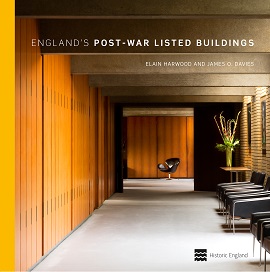Engineering Building, Leicester University
Major’s Walk, Leicester
1960–3
James Stirling and James Gowan
Engineer: Frank Newby of Felix Samuely and Partners
Listed grade II*, 30 March 1993
This is a building of international significance, which defined modernism’s late-1950s shift towards a greater individualism and gave it a truly British character. Leicester eschewed Scandinavian influences for liver red Accrington brick and Dutch tiles, with aluminium-framed patent glazing, an updating of the industrial architecture of England’s nineteenth-century cities. Such a use of Victorian elements combined with constructivist forms and a twelve-storey tower is dramatic.
Leicester has the tightest site of the post-war universities, and the architects had to squeeze in workshops for heavy machinery, laboratories, lecture theatres, and a 30.5m (100ft) water tank to serve hydraulic experiments. The workshops, covering two-thirds of the area, had to have north-light glazing, but the plot does not run north–south. So while the building uses its site efficiently, the glazing runs at a diagonal, developed as a low-cost solution by Newby but denoted by wilful, lozenge-shaped terminals devised by Gowan. The interior is overwhelming because of the glowing, translucent light that results.
Comparisons can be made with Frank Lloyd Wright’s Johnson Wax complex at Racine, Wisconsin, the saturated light of the large, single-storey interiors similarly contrasted with their banded towers. The shapely forms of Leicester’s tower, thrust out on the stepping of two projecting lecture theatres, are credited to Stirling, again as refined by Newby.
The synthesis between Stirling and Gowan’s contrasting approaches gives the surprisingly skinny building its tautness. The partnership collapsed soon afterwards and, despite their subsequent individual achievements, for most critics this remains the sublime monument of the new brutalism. Perhaps the true partnership was between the architects and their engineer.
This was first published in 'England's Post-War Listed Buildings' by Elain Harwood and James O. Davies. Read a review of the book and interview with Elain Harwood here.
Read other extracts from the book:
Featured articles and news
RTPI leader to become new CIOB Chief Executive Officer
Dr Victoria Hills MRTPI, FICE to take over after Caroline Gumble’s departure.
Social and affordable housing, a long term plan for delivery
The “Delivering a Decade of Renewal for Social and Affordable Housing” strategy sets out future path.
A change to adoptive architecture
Effects of global weather warming on architectural detailing, material choice and human interaction.
The proposed publicly owned and backed subsidiary of Homes England, to facilitate new homes.
How big is the problem and what can we do to mitigate the effects?
Overheating guidance and tools for building designers
A number of cool guides to help with the heat.
The UK's Modern Industrial Strategy: A 10 year plan
Previous consultation criticism, current key elements and general support with some persisting reservations.
Building Safety Regulator reforms
New roles, new staff and a new fast track service pave the way for a single construction regulator.
Architectural Technologist CPDs and Communications
CIAT CPD… and how you can do it!
Cooling centres and cool spaces
Managing extreme heat in cities by directing the public to places for heat stress relief and water sources.
Winter gardens: A brief history and warm variations
Extending the season with glass in different forms and terms.
Restoring Great Yarmouth's Winter Gardens
Transforming one of the least sustainable constructions imaginable.
Construction Skills Mission Board launch sector drive
Newly formed government and industry collaboration set strategy for recruiting an additional 100,000 construction workers a year.
New Architects Code comes into effect in September 2025
ARB Architects Code of Conduct and Practice available with ongoing consultation regarding guidance.
Welsh Skills Body (Medr) launches ambitious plan
The new skills body brings together funding and regulation of tertiary education and research for the devolved nation.
Paul Gandy FCIOB announced as next CIOB President
Former Tilbury Douglas CEO takes helm.
UK Infrastructure: A 10 Year Strategy. In brief with reactions
With the National Infrastructure and Service Transformation Authority (NISTA).
























